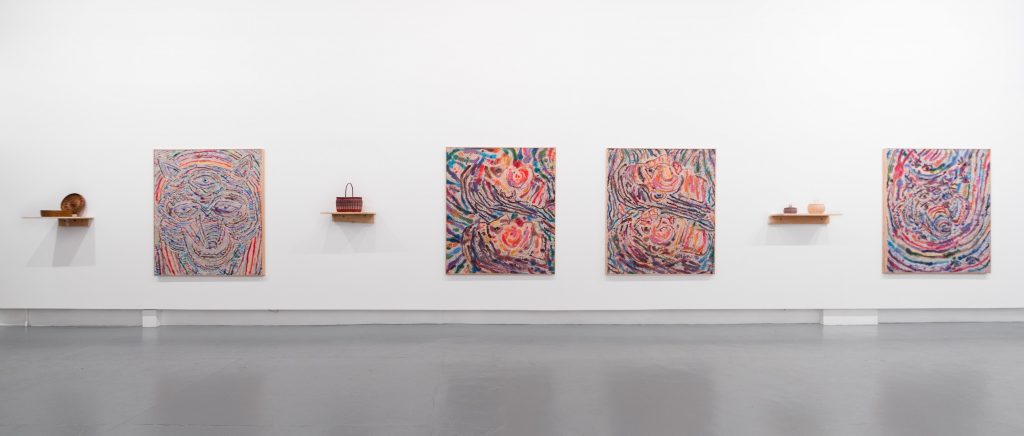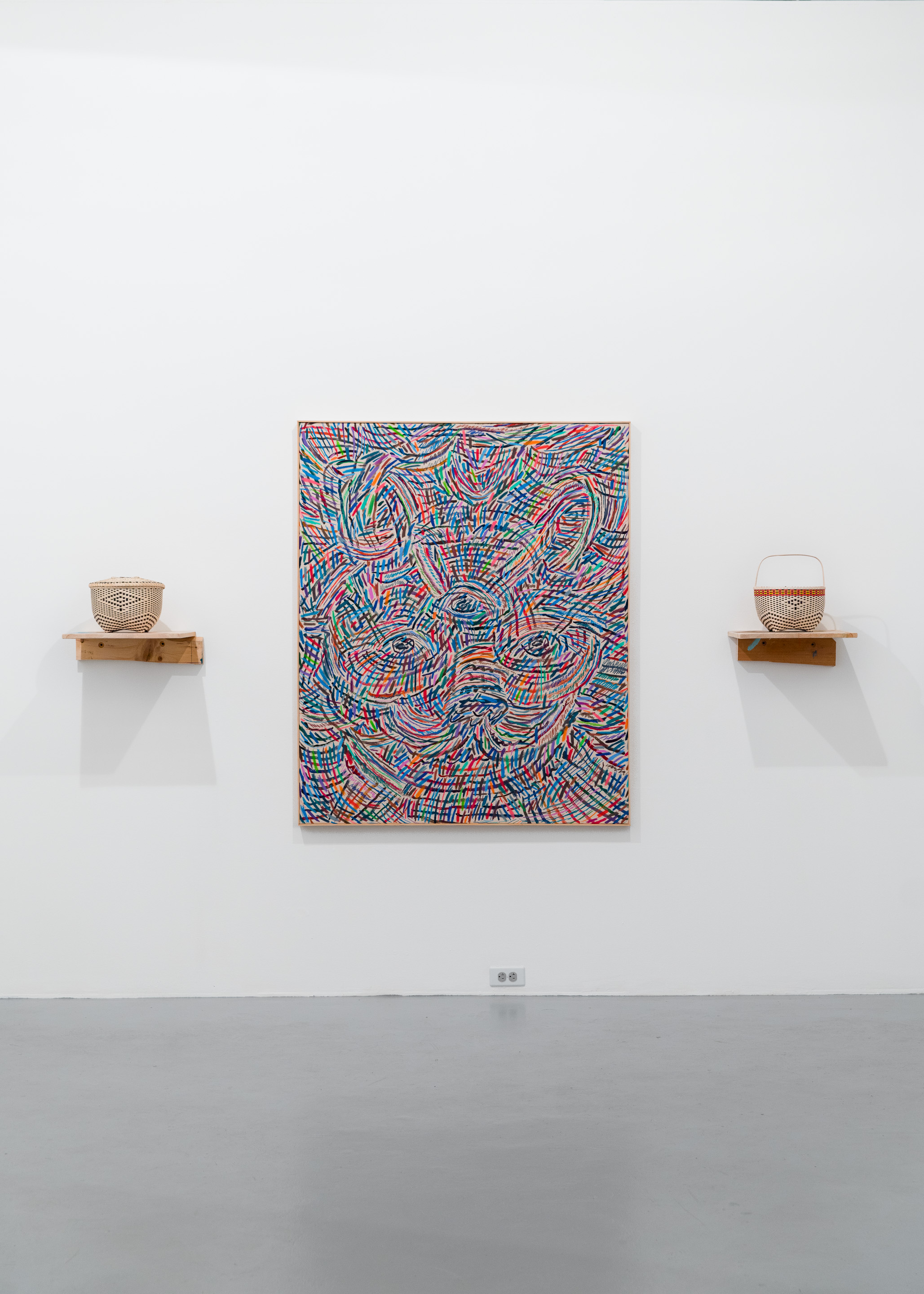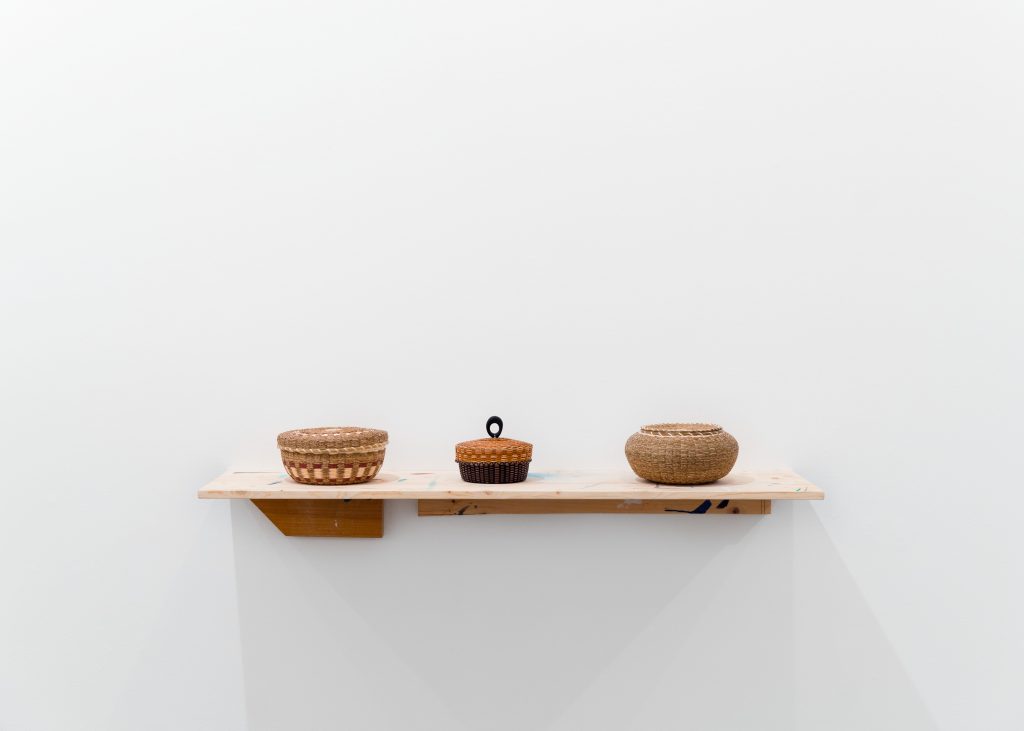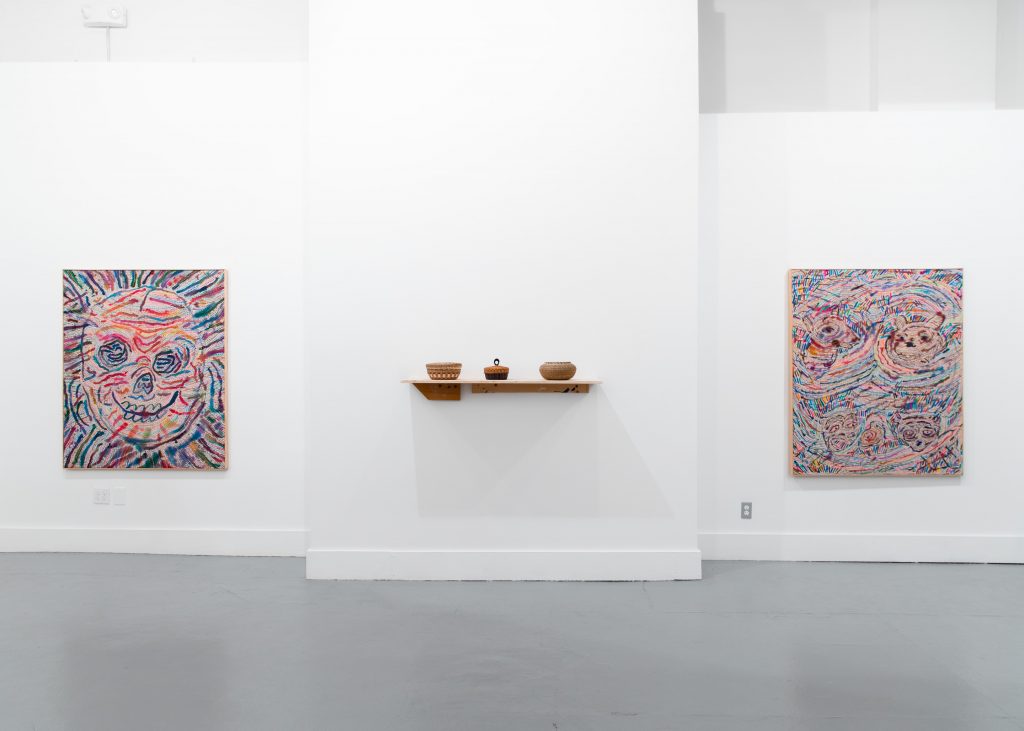I spoke with Howard Fonda on Friday, August 2nd, the morning his exhibition, Carry Me, opened at SPACE. We discussed the ethics of blurring boundaries between categories in contemporary art, the nature of change within traditions of art making, and how the desire to forefront the formal connections across artworks in the show is also a form of institutional critique.

The title of your exhibition here at SPACE is “Carry Me”? How did that come about?
It was really just something that popped into my head and resonated. It is a bit of a play on words because all the work in the show is a vessel except for my paintings. But it also relates to ways that I think about certain philosophical notions that I toil with. Sometimes I find answers or clues within different forms of spirituality around the world. I often look to people who were native to this continent. It has just always resonated with me. On another level, the ideas of tradition, notions of the spiritual, these are things that I as a white male don’t have a lot of ownership of for myself, or if those things do exist in my background, I don’t have a lot of connection to them. I have always found those connections elsewhere.
You shared you are a fan of the artist Jeremy Frey, who is a prominent Passamaquoddy basketmaker. Was he your first introduction to this regional tradition in Maine? And the contemporary artists still working within those traditions?
Yes. I am a huge fan of his work and I started following him online. I wrote him out of the blue and was astonished that he wrote back! My original idea for this exhibition came with him in mind- I wanted to put my work in conversation with contemporary basketmakers in the region, but I needed to talk with someone within the community about it. Is this even a good idea? I don’t know, I wanted a sense of approval or something, or just to hear some honest feedback. It was a reality check when we spoke though, because he is so incredibly well collected and sought after that he didn’t have a lot of baskets on hand and available. His making process is also methodical- baskets can take 6 months for him to make. So much planning and foresight would have been needed to execute the original idea.
But then things coalesced and came together and obviously, none of this would have happened without SPACE and Beverly Werber and Peter Goldman. I mean, Space was the catalyst that allowed me to move forward with this idea. I am so humbled and grateful to you. To be able to realize this and have my work in conversation with artists in the region, within the community, it’s amazing. Then to find out the Maine Historical Society down the street is showing Wabanaki baskets too in their exhibition Holding up the Sky. It’s just so prescient and in the air. It felt wonderful to be able to grab onto an idea, see it through, and feel the interest around it.
Jeremy also shared some really valuable perspective on the traditions he is working within. He used to get flack from elders and people within the Native community because his designs were getting more radical and departing from traditional forms. Even in some of his material preparation, he would ask women to help with roles that were traditionally given for men. He is interested in how things evolve within a tradition- 100 years ago people changed designs just a little bit too. That is what keeps the tradition alive. It’s always moving. I think it’s really interesting to think about that variance over time. Things are not as fixed as we think. It’s the same for someone who is making contemporary painting too.
You use the word “folksy” when you describe your painting style. What does this mean for you? Can you share your perspective on the field of Folk Art?
I dunno. I don’t know if that is the best language. I think these paintings in particular are really new and I haven’t sat with them very long. It’s a new process. But it came up in conversation in a few studio visits. I wouldn’t necessarily talk about the paintings in those terms, but I like the colloquial nature of the phrase. I didn’t want to attach a bunch of artspeak to things and get buried in academic language around artistic fields. Though I think the show and the conversation around the show is ripe for that discussion. But I don’t think I am the one best equipped to do that.
Do you find influences in Folk Art formally or conceptually?
Absolutely. All types of Folk Art, Self-Taught Art, and Native Art. For me, it is all about modes of communication. In a nutshell, that is what I am doing when I am in the studio- I’m trying to communicate something. A way of figuring out the world.
Growing up on the East Coast, with parents who were super into antiques, that history and a reverence for history was embedded in me. Everything has stories and meaning behind it. You know, growing up in an old house and you ding the wall when you are moving a bedframe and there are 7 different colors of paint and an old newspaper embedded in the walls. Objects hold so much history and can tell so many tales- that has always excited me. What we call “fine art” can offer that experience too, but so much of my experience with Folk Art is that traditions are more accessible in the work- I find a lot of meaning in that. I am drawn to it.
When I look at the exhibition, I see immediate formal connections between the baskets and your paintings, from the pattern of the weaving and your pattern of mark-making, to the color gradations. Outside of these formal connections, were there other throughlines you were hoping to draw?
The impetus was really the formal relationships. The idea of seeing the work of the hand in the mark-making. Seeing the construction of an object within an object. But I am also quite aware of the other conversation: the hierarchies of the art world and how that has operated historically. The obvious- what I hope is obvious and I hope we are all aware of and all talking about- about how you still walk through museums and it is predominantly white men’s art. Where is everyone else? Those are absolutely important conversations. Maybe I am naive, but I would hope that is obvious. That is a dialogue we should all be involved in already! My focus here is on the formal relationships, and a group of artists’ work together. It shouldn’t feel so radical, but maybe it still is.
I just don’t want the show to be couched in institutional critique. It’s an obvious, ongoing conversation and one that should be had. But I want the show first and foremost to be about the art and the visual experience of it. About the objects. Then by extension, we are led into other dialogues. We should critique not just museums, don’t stop there, right? So much is fucked up in 2019.
But museums as keepers of history and history makers are uniquely positioned to reinforce or dismantle certain narratives. Wabanki makers are at the forefront of decolonizing efforts in Maine. Just by advocating for their works to be seen as contemporary. Just by advocating for their voice to be present in the contemporary landscape.
Yes, and I have my opinions about all of that. But, I don’t know if I should be lending my voice to these issues. I would be much more interested in hearing from the other artists in the show and their thoughts about that dialogue. They have more ownership for that conversation- I just want to support it.
How do you think about your power dynamics as a white man within the contemporary art world wanting to support decolonizing movements? Or wanting to exhibit your work in dialogue with Native artists?
I know I am very lucky to have the opportunity to come here and do the residency and do the show at SPACE. It’s hard not to be hyper aware of that privilege. There is no way around it.
There is a personal level for me too. I do think from the beginning I have been very cynical and distrusting of dominant culture. I think growing up in this little farm town in upstate New York, and clearly I am not, but I always felt like an other. The music I listened to, the way I dressed, the way I looked, people always judged me on that. The way I found community was connecting with all these other people who were marginalized. I identified more with them. I also would sit in history class and I didn’t understand the story I was being told, and then I would go to different historical sites and just know that this wasn’t the whole story. There was so much untold, and I always struggled with the narrow narrative that was being fed to me.
I also have been really fortunate to have such strong female role models in my life and that has impacted my worldview so much. More than I can say. I know I can’t step outside of being a white man, I am what I am. But that is my least interesting attribute. The culture of white men is what has resonated the least for me in my life.
I think there are a lot of white artists who exist in a position of privilege, who might want to put their work in conversation with artists whose practices are more marginalized from the mainstream, but they stop because they worry about uneven power dynamics and tokenizing. Did you have concerns?
Sure. But this isn’t some “dances with wolves” shit – the white guy comes in and saves the day narrative. That is the worst. The work is in the show because it is badass work. Period. I mean, shouldn’t it always be about the art? Isn’t the object even more important than the artist?
I think it becomes political for mainstream art institutions when decisions have to be made about what gets to be on view. The number of people who hold that decision making ability don’t always embrace change quickly or easily, or share power. The object should be more important than the artist, but what about when the artist’s identity is part of the content of the work. I don’t know that it can always be separated.
I get it. I know it’s not black and white. It’s all grey. The world is all grey. Maybe that is something we all need to recognize.
We had talked earlier about how the Wabanaki artists in the show are making this fiercely contemporary work, but it is tied to a deep tradition of making. Do you relate to that combination? You are a contemporary artist making work right now, but do you feel tied to a tradition? A tradition of painting?
I do. Absolutely. I think that is one of the reasons why I am so drawn to painting especially in today’s visual climate. Because it’s so archaic. It’s so useless. It has no other function. It is so dated. All those limitations. Within all of that uselessness is its power. It can’t be any other thing, so you have to address it on its terms. You can’t consume it so quickly like you can with say, pop media, or social media.
And it can’t be confused as a tool for other things like photography can.
Yeah, it can’t be confused. I like all the painting baggage. I like that “burden”.
Can you share some of your favorite painters? People working now or more historical figures?
Contemporary painters- so many. I like Shara Hughes. Austin Eddy. Theodora Allen. Marley Freeman. Rebecca Morris. Mari Eastman is one of my favorite painters of all time. Michelle Grabner. Sophie Von Hellerman. Karen Kilimnick. So many!
You know, I started out undergrad coming from a small town and I went to art school in New York with a very limited art historical background. I took my first painting class in college. One of my first assignments was to go to MOMA and see a Cy Twombly show and write about it. I had no idea who Cy Twombly was. I remember walking in and my mind was just blown. I still get goosebumps thinking about it today. His scale, his mark, all of it. I had such a strong reaction- This is ok? I can do this? Of course that led to a trajectory of other painters breaking boundaries- Basquiat was another big influence. It was very validating and liberating. This feeling, like “I can do me and it’s ok.” So of course Twombly, of course Basquait. And, Manet. Always Manet. When we were living in Chicago I would go to the Art Institute and spend a lot of time in front of those Manets. A lot.





